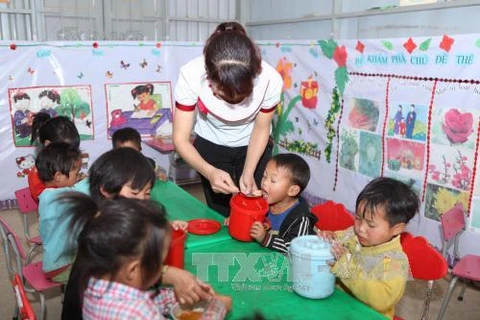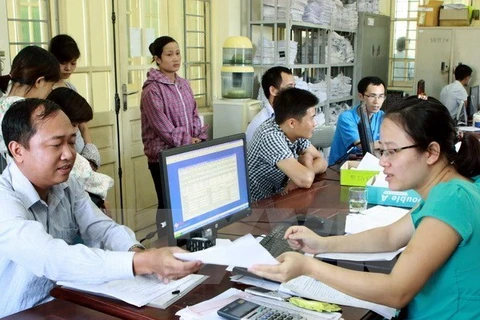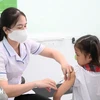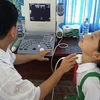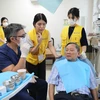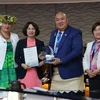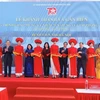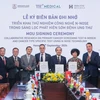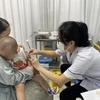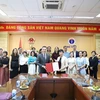 Hospitals invest in modern equipment to check up and treat health insurance cardholders (Photo: VNA).
Hospitals invest in modern equipment to check up and treat health insurance cardholders (Photo: VNA). Hanoi (VNA) – The six-year implementation of the revised Law on Health Insurance has produced positive results in carrying out health insurance-related policies, with the rate of health insurance coverage reaching nearly 90 percent of Vietnam’s population.
The Law on Health Insurance, issued in 2008 and revised in 2014, is a legal foundation institutionalising the Party and State’s stance and orientations in implementing a public health financial policy through health insurance for all people in a fair, effective and development manner.
The reality shows that the better policies and laws related to health insurance are, the sooner the goal of health insurance covering all people is achieved.
In recent years, the Vietnam Social Security (VSS), with its responsibility as an office organising the enforcement of the law, has exerted every effort to enforce health insurance policies and laws.
Impressive results
VSS Deputy General Director Pham Luong Son said that after nearly six years, the enforcement of the amended Law on Health Insurance has produced outstanding outcomes in organising the implementation of relevant policies.
Specifically, the health insurance coverage rate reaches nearly 90 percent of the population, with the number of participants rising by 48 percent each year during 2015-2019 to 85.6 million last year.
Notably, the health insurance coverage has focused on vulnerable groups such as labourers (over 90 percent), retired people and those losing their labour force or receiving social assistance (100 percent – 3.1 million people), those supported by the State such as near-poor households and students (nearly 100 percent) and over 17.5 million people buying social insurance in the household form.
“It can be said that Vietnam has basically fulfilled its goal of universal health insurance coverage and finished ahead of schedule compared to the target set out in the Politburo’s Resolution No.21-NQ/TW dated November 22, 2012, on strengthening the Party’s leadership over social insurance and health insurance in the 2012-2020 period,” stressed Son.
Therefore, the target of 95 percent of the health insurance coverage rate in 2025 as mentioned in Resolution No.20-NQ/TW dated October 25, 2017 of the 12th Party Central Committee’s sixth session on intensifying the protection, care and improvement of people’s care is completely reachable, Son said.
Son attributed the results to efforts of the social insurance sector as well as close coordination between relevant ministries and sectors. The VSS has allocated the quota to each locality and actively coordinated with the Health Ministry and involved ministries and sectors and People’s Committees of provinces and cities in promptly dealing with the difficulties locals are facing.
According to VSS statistics, the number of health clinics accepting the use of health insurance in medical check-ups and treatment raised from 2,111 in 2014 to 2,571 in June 2020, up 22 percent. Of them, the number of private health establishments doubled from 424 in 2014 to 835.
In fact, there are more and more opportunities to access check-up and treatment services using health insurance, and more and more check-ups paid by the health insurance fund.
The number of people using health insurance when going for health check-ups and treatment doubled after a decade from 92.1 million in 2009 to 186 million in 2019. Spending on health check-ups and treatment from the health insurance fund rose from 15.5 trillion VND (970 million USD) in 2009 to over 100 trillion VND last year.
Paying for more than 18,000 technical services
The VSS Deputy General Director said that the health insurance policy has helped reduce households’ spending on health services, thus contributing to ensuring the fairness in health care, especially for vulnerable groups such as poor and near-poor people, people with disabilities, those receiving social assistance, and children aged under six.
In many cases, the health insurance fund has paid billions of Vietnamese dong in medical expenses in one year.
Patients with health insurance are covered with more than 18,000 medical technical services, including high-cost high-tech services such as cardiovascular interventions and surgeries, endoscopy, MRI, CT and PET-CT.
In addition, health insurance covers thousands of types of medical supplies, including alternative medical supplies such as pacemakers, coronary stents and artificial joints.
Vietnam’s health insurance coverage is assessed by many international organisations to be broad compared to many countries in the region and in the world.
In 2018, collection from health insurance participants was 93.318 trillion VND; equal to 105.8 percent of the assigned target. Total expenses related to health insurance surpassed 95 trillion VND, equal to 104.3 percent of the estimates assigned by the Government.
In 2019, the collection is estimated at 104.8 trillion VND, while spending is estimated at 104.44 trillion VND. The balance of collection and spending is ensured, without using the reserve fund.
In addition to achievements, Son said that the sustainable development of a health insurance policy is also facing many challenges as the population ages, there are changes in disease patterns, and increasing spending for medical check-ups and treatment.
Therefore, to reach 95 percent of the population covered by health insurance by 2025, Son suggested Vietnam focus on synchronously carrying out measures to develop the number of participants, and manage and use the health insurance fund effectively, and protect the interests of participants./.

